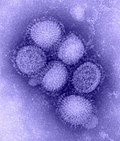Influenza A virus subtype H1N1
Influenza A virus subtype H1N1 (A/H1N1) is a subtype of Influenza A virus, an orthomyxovirus that can cause respiratory infections in humans and various animal species. This subtype has been responsible for several significant pandemics, including the 2009 swine flu pandemic, the 1977 Russian flu pandemic, and the 1918 Spanish flu pandemic. H1N1 viruses are characterized by the presence of two glycoproteins on their surface: hemagglutinin (H1) and neuraminidase (N1).
Structure and Function[edit]
The H1N1 virus contains the glycoproteins hemagglutinin (H1) and neuraminidase (N1), which play critical roles in the infection process:
- Hemagglutinin (H1): This protein causes red blood cells to clump together (agglutinate) and enables the virus to bind to and enter the host cell. Hemagglutinin also facilitates the fusion of the viral envelope with the host cell membrane, allowing the viral genetic material to enter the cell.
- Neuraminidase (N1): This enzyme is a type of glycoside hydrolase that helps the virus particles move through the infected cell and assists in their release from the host cell by cleaving sialic acid residues on the cell surface. This process enables the newly formed virus particles to spread and infect other cells.
Transmission[edit]
H1N1 viruses are primarily transmitted through respiratory droplets, which can be expelled by infected individuals when they cough, sneeze, or talk. The virus can also spread via contact with contaminated surfaces or objects, followed by touching the mouth, nose, or eyes. In rare cases, H1N1 viruses can be transmitted through contact with infected animals or consumption of contaminated food products.
Prevention and Treatment[edit]
Prevention strategies for H1N1 infections include:
- Influenza vaccination: Annual vaccination is recommended to protect against seasonal influenza strains, including H1N1. The vaccine composition is updated annually based on the World Health Organization's recommendations to provide the best protection against circulating viruses.
- Hygiene measures: Frequent handwashing, use of hand sanitizers, and proper respiratory hygiene (e.g., covering the mouth and nose when coughing or sneezing) can help reduce the spread of the virus.
Social distancing: During outbreaks or pandemics, social distancing measures (e.g., staying home when sick, avoiding large gatherings) can help slow down the transmission of the virus. Treatment options for H1N1 infections include:
- Antiviral medications: Drugs such as oseltamivir (Tamiflu) and zanamivir (Relenza) can be used to treat H1N1 infections if administered within 48 hours of the onset of symptoms. These medications work by inhibiting neuraminidase, which helps to prevent the release and spread of the virus within the body.
8 Supportive care: There is no specific cure for H1N1 infections, so treatment mainly focuses on relieving symptoms and providing supportive care. This may include rest, hydration, over-the-counter medications for fever and pain, and, in severe cases, hospitalization for oxygen therapy or mechanical ventilation.
Notable Outbreaks[edit]
H1N1 subtype viruses have been responsible for several major pandemics in human history:
- 1918 Spanish flu pandemic: This pandemic, which occurred between 1918 and 1920, infected an estimated 500 million people worldwide and resulted in the deaths of 50 to 100 million individuals. It is considered one of the deadliest pandemics in human history.
- 1977 Russian flu pandemic: This outbreak, which primarily affected young people, was less severe than the 1918 pandemic but still caused significant morbidity and mortality.
- 2009 swine flu pandemic: Originating in Mexico, this pandemic spread rapidly across the globe and was declared a pandemic by the World Health Organization in June 2009. The virus primarily affected children and young adults, and although it had a lower overall mortality rate than previous pandemics, it still resulted in an estimated 150,000 to 575,000 deaths worldwide.
See also[edit]
Ad. Transform your life with W8MD's Budget GLP-1 injections from $75


W8MD offers a medical weight loss program to lose weight in Philadelphia. Our physician-supervised medical weight loss provides:
- Weight loss injections in NYC (generic and brand names):
- Zepbound / Mounjaro, Wegovy / Ozempic, Saxenda
- Most insurances accepted or discounted self-pay rates. We will obtain insurance prior authorizations if needed.
- Generic GLP1 weight loss injections from $75 for the starting dose.
- Also offer prescription weight loss medications including Phentermine, Qsymia, Diethylpropion, Contrave etc.
NYC weight loss doctor appointmentsNYC weight loss doctor appointments
Start your NYC weight loss journey today at our NYC medical weight loss and Philadelphia medical weight loss clinics.
- Call 718-946-5500 to lose weight in NYC or for medical weight loss in Philadelphia 215-676-2334.
- Tags:NYC medical weight loss, Philadelphia lose weight Zepbound NYC, Budget GLP1 weight loss injections, Wegovy Philadelphia, Wegovy NYC, Philadelphia medical weight loss, Brookly weight loss and Wegovy NYC
|
WikiMD's Wellness Encyclopedia |
| Let Food Be Thy Medicine Medicine Thy Food - Hippocrates |
Medical Disclaimer: WikiMD is not a substitute for professional medical advice. The information on WikiMD is provided as an information resource only, may be incorrect, outdated or misleading, and is not to be used or relied on for any diagnostic or treatment purposes. Please consult your health care provider before making any healthcare decisions or for guidance about a specific medical condition. WikiMD expressly disclaims responsibility, and shall have no liability, for any damages, loss, injury, or liability whatsoever suffered as a result of your reliance on the information contained in this site. By visiting this site you agree to the foregoing terms and conditions, which may from time to time be changed or supplemented by WikiMD. If you do not agree to the foregoing terms and conditions, you should not enter or use this site. See full disclaimer.
Credits:Most images are courtesy of Wikimedia commons, and templates, categories Wikipedia, licensed under CC BY SA or similar.
Translate this page: - East Asian
中文,
日本,
한국어,
South Asian
हिन्दी,
தமிழ்,
తెలుగు,
Urdu,
ಕನ್ನಡ,
Southeast Asian
Indonesian,
Vietnamese,
Thai,
မြန်မာဘာသာ,
বাংলা
European
español,
Deutsch,
français,
Greek,
português do Brasil,
polski,
română,
русский,
Nederlands,
norsk,
svenska,
suomi,
Italian
Middle Eastern & African
عربى,
Turkish,
Persian,
Hebrew,
Afrikaans,
isiZulu,
Kiswahili,
Other
Bulgarian,
Hungarian,
Czech,
Swedish,
മലയാളം,
मराठी,
ਪੰਜਾਬੀ,
ગુજરાતી,
Portuguese,
Ukrainian





